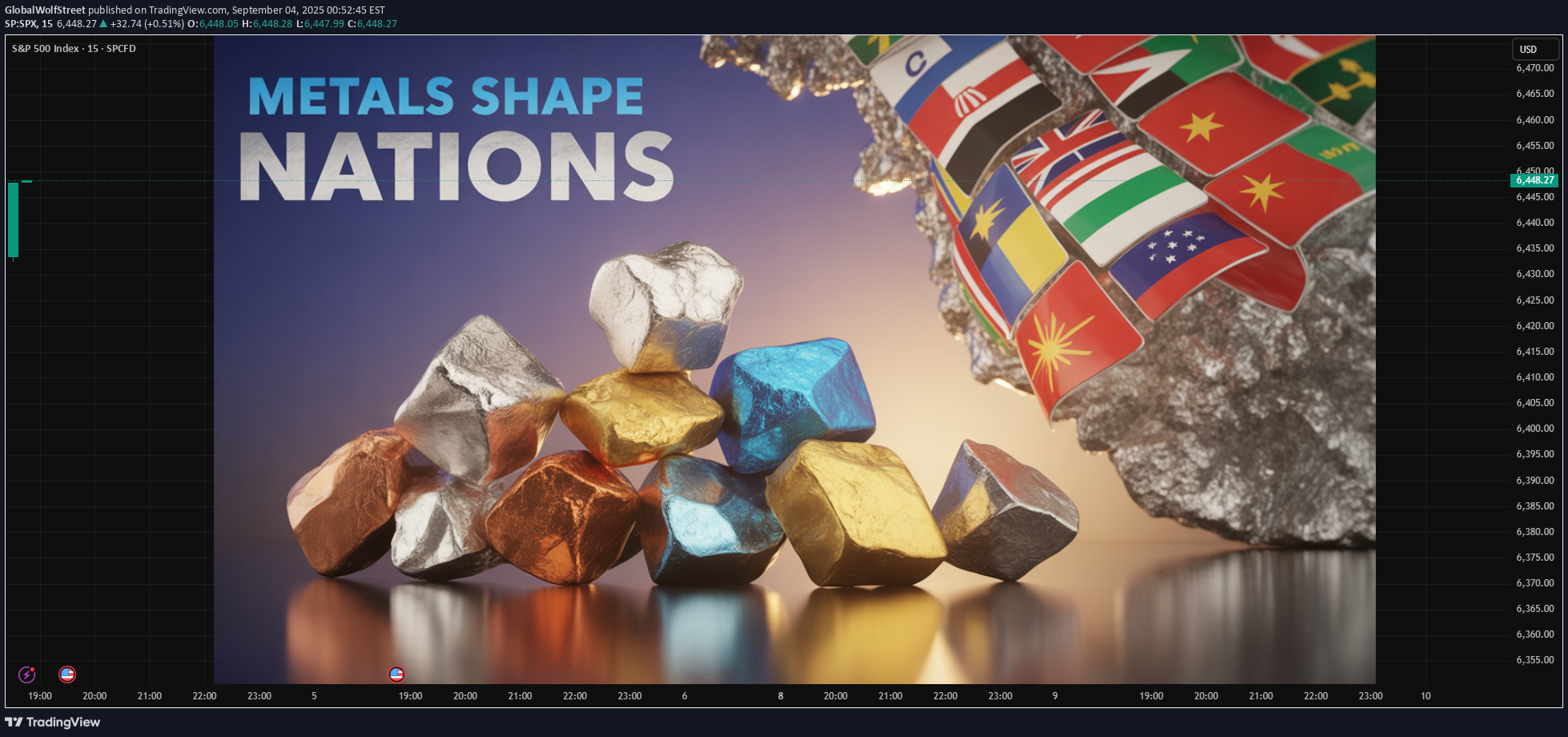Technical analysis by GlobalWolfStreet about Symbol SPYX on 9/4/2025

Introduction In the 21st century, natural resources continue to shape geopolitics, economic power, and technological advancement. Just as oil defined much of the 20th century’s geopolitical struggles, rare earth metals (REMs) are increasingly being seen as the strategic resource of the digital and green-energy era. These 17 chemically similar elements—scattered in nature yet crucial for modern technologies—have become central to industries ranging from defense systems and electronics to renewable energy and electric mobility. The geopolitical importance of rare earth metals arises from their scarcity in economically viable concentrations, their critical role in high-tech applications, and the fact that global production is highly concentrated in a few countries, particularly China. This combination of economic necessity and strategic vulnerability makes rare earth metals one of the most contested resources of our time. This essay explores the science, applications, production dynamics, geopolitical tensions, and future outlook of rare earth metals. By the end, it becomes clear why these “hidden metals” are at the heart of modern geopolitics. 1. Understanding Rare Earth Metals 1.1 What Are Rare Earth Metals? Rare earth metals are a group of 17 elements on the periodic table, specifically the 15 lanthanides plus scandium and yttrium. Despite their name, they are not particularly rare in the Earth’s crust. In fact, elements such as cerium are more abundant than copper. What makes them “rare” is that they are rarely found in concentrated, economically minable deposits. Extracting them is technically challenging and environmentally damaging, making supply chains vulnerable. 1.2 Types of Rare Earth Elements They are typically divided into two categories: Light Rare Earth Elements (LREEs): Lanthanum, cerium, praseodymium, neodymium, promethium, and samarium. Heavy Rare Earth Elements (HREEs): Europium, gadolinium, terbium, dysprosium, holmium, erbium, thulium, ytterbium, lutetium, plus yttrium. HREEs are generally scarcer and more geopolitically significant because they are harder to find and extract. 1.3 Properties That Make Them Critical Rare earths have unique magnetic, luminescent, and electrochemical properties. For example: Neodymium produces powerful permanent magnets. Europium provides the red color in LED and display technologies. Dysprosium improves magnet performance at high temperatures. Lanthanum is used in camera lenses and batteries. Such applications make them essential in modern life, often irreplaceable. 2. Strategic Applications of Rare Earth Metals 2.1 Consumer Electronics Smartphones, laptops, tablets, and televisions rely heavily on rare earths. A smartphone alone may contain up to 8–10 different rare earth elements for screens, vibration motors, and microelectronics. 2.2 Renewable Energy Wind turbines: Use large amounts of neodymium and dysprosium in permanent magnets. Solar panels: Depend on cerium and europium for polishing glass and improving efficiency. Electric vehicles (EVs): Motors require neodymium, praseodymium, and dysprosium. The global push toward net-zero emissions is driving up rare earth demand exponentially. 2.3 Defense and Aerospace Rare earths are essential in defense systems: Jet engines (yttrium, europium) Precision-guided munitions (neodymium magnets) Communication systems Radar and sonar technology The U.S. Department of Defense considers them critical for national security. 2.4 Medical Technologies MRI machines, X-ray intensifiers, and other diagnostic devices rely on rare earths such as gadolinium. 2.5 Industrial Uses Catalysts in oil refining, glass polishing, and metallurgy all depend on rare earths, making them indispensable for both civilian and industrial economies. 3. Global Production and Supply Chain 3.1 China’s Dominance China is the world’s largest producer of rare earths, accounting for 60–70% of global production and nearly 85–90% of processing capacity. This dominance emerged in the 1990s when China deliberately underpriced rare earth exports, forcing competitors in the U.S. and elsewhere to shut down due to environmental costs and unprofitability. By controlling not just mining but also refining and manufacturing, China has become the hub of the rare earth supply chain. 3.2 Other Producers United States: Mountain Pass mine in California is the largest rare earth mine outside China but depends on China for refining. Australia: Lynas Corporation is a major non-Chinese producer. India, Russia, Myanmar, and Brazil also contribute but at smaller scales. 3.3 Supply Chain Vulnerabilities Mining rare earths is only the first step. Refining and separation are highly complex, and China’s near-monopoly over processing makes the global supply chain fragile. Disruptions in China could impact industries worldwide, from EVs to defense systems. 4. Environmental and Social Implications 4.1 Environmental Damage Rare earth mining is associated with severe environmental impacts: Radioactive waste (thorium and uranium traces). Water pollution from acid leaching. Deforestation and land degradation. China’s Baotou region, a hub for rare earth mining, has been heavily polluted, leading to health and ecological crises. 4.2 Local Community Impact Communities around rare earth mines face displacement, water scarcity, and long-term health risks. Balancing demand with sustainable mining practices remains a global challenge. 5. Geopolitical Importance 5.1 Rare Earths as a Strategic Resource Like oil in the 20th century, rare earths are now “strategic resources.” Countries reliant on imports are vulnerable to supply disruptions, price manipulation, and geopolitical bargaining. 5.2 China’s Leverage China has used rare earths as a geopolitical tool: In 2010, China restricted exports to Japan amid territorial disputes, crippling Japan’s high-tech industry temporarily. China has hinted at restricting supply to the U.S. during trade tensions. Such actions demonstrate how resource control translates into geopolitical influence. 5.3 U.S. and Western Response The U.S., EU, Japan, and Australia have launched initiatives to reduce dependency on China. These include: Strategic stockpiling of rare earths. New mining projects in Africa, Greenland, and Australia. Research into recycling and substitutes for rare earths. However, creating a parallel supply chain is costly and time-consuming. 5.4 Role in Green Energy Transition As nations push for renewable energy and electric vehicles, rare earths are becoming central to climate policy. This adds another layer of geopolitical competition, as access to rare earths could determine leadership in green technology. 6. Emerging Geopolitical Trends 6.1 Resource Nationalism Countries rich in rare earth deposits, such as Myanmar, Vietnam, and African nations, are increasingly asserting control. They see rare earths as a path to economic growth and geopolitical relevance. 6.2 Strategic Alliances The Quad Alliance (U.S., India, Japan, Australia) has discussed collaboration in rare earth supply chains to counterbalance China. The EU is also exploring partnerships with African and Latin American producers. 6.3 Competition in the Arctic Greenland has significant rare earth deposits. With melting ice making access easier, both China and Western nations are vying for influence in the Arctic region. 6.4 Technological Race Nations are investing in R&D to find alternatives to rare earths or to improve recycling technologies. Whoever leads in this race could reduce dependence on geopolitically unstable supply chains. 7. Future Outlook 7.1 Demand Projections The demand for rare earths is projected to triple by 2040, driven by: Electric vehicles Renewable energy installations Advanced military technology This means competition will intensify. 7.2 Recycling and Circular Economy Recycling rare earths from e-waste and magnets offers a partial solution. However, technical and economic barriers remain significant. 7.3 Substitutes and Innovation Some research is focused on developing magnet technologies that reduce reliance on rare earths. Success in this area could reshape the geopolitical importance of these elements. 7.4 Multipolar Supply Chains Efforts by Australia, the U.S., and Europe to build alternative refining and mining operations could reduce China’s dominance over time, though it will take decades. 8. Case Studies 8.1 Japan’s Strategy Post-2010 After China restricted exports in 2010, Japan diversified its supply by investing in mines in Vietnam and Australia. It also accelerated recycling technologies, making Japan less vulnerable today. 8.2 U.S. Strategic Stockpiling The U.S. Defense Production Act has been used to stockpile rare earths, particularly for defense applications, highlighting their importance in national security. 8.3 Africa as a Future Powerhouse Countries like Malawi, Tanzania, and Madagascar hold significant deposits. China has already invested heavily in African mines, but Western nations are increasing their presence to secure supply. 9. Challenges Ahead Balancing environmental concerns with rising demand. Avoiding overdependence on a single producer nation. Managing geopolitical rivalries without triggering resource wars. Ensuring fair distribution of benefits for resource-rich but economically poor nations. Conclusion Rare earth metals are the invisible backbone of the digital, defense, and green revolutions. They may not dominate headlines like oil, but they are no less critical to global security and economic stability. Their importance lies not only in their industrial applications but also in the geopolitical leverage they confer upon producing nations. As the world transitions toward renewable energy and advanced technologies, rare earths will become even more strategic. The competition over access, processing, and innovation will define geopolitical alignments in the coming decades. Nations that secure stable supply chains and invest in sustainable alternatives will gain a decisive advantage in the 21st-century global order. In many ways, rare earths are the new oil—quietly powering economies, shaping foreign policies, and fueling the next era of great power competition.
